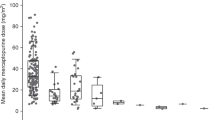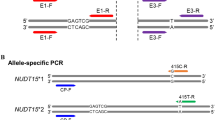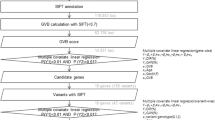Abstract
A recent study identified a variant of the NUDT15 gene (rs116855232 C>T) associated with intolerance to thiopurine in Korean patients with Crohn’s disease. This study prompted us to substantiate the finding in a Taiwanese population. Four hundred and four children with acute lymphoblastic leukemia (ALL), and 100 adults with chronic immune thrombocytopenic purpura or localized lymphoma having normal bone marrow were examined. Two candidate gene approaches, pyrosequencing for NUDT15 and TaqMan assay for thiopurine methyltransferase (TPMT) genotyping (rs1142345 A>G), were performed. We showed a risk allele frequency of NUDT15 of 11.6% in children with ALL and 15.5% in adults. By contrast, the risk allele frequency of TPMT was only 1.6% in children with ALL and 0.5% in adults. The high frequency of risk variant for NUDT15, but not the very low frequency of risk variant for TPMT, was closely associated with the intolerance to mercaptopurine in children with ALL in Taiwan, contrast to that of European descent. In regard to NUDT15 polymorphism, the maximal tolerable daily doses of mercaptopurine in homozygotes, heterozygotes and wild-type groups were 9.4 mg m−2, 30.7 mg m−2 and 44.1 mg m−2, respectively. The outcomes did not differ significantly among the different genotypes.
This is a preview of subscription content, access via your institution
Access options
Subscribe to this journal
Receive 6 print issues and online access
$259.00 per year
only $43.17 per issue
Buy this article
- Purchase on Springer Link
- Instant access to full article PDF
Prices may be subject to local taxes which are calculated during checkout





Similar content being viewed by others

References
Pui CH, Carroll WL, Meshinchi S, Arceci RJ . Biology, risk stratification, and therapy of pediatric acute leukemias: an update. J Clin Oncol 2011; 29: 551–565.
Hunger SP, Lu X, Devidas M, Camitta BM, Gaynon PS, Winick NJ et al. Improved survival for children and adolescents with acute lymphoblastic leukemia between 1990 and 2005: a report from the children's oncology group. J Clin Oncol 2012; 30: 1663–1669.
Moricke A, Zimmermann M, Reiter A, Henze G, Schrauder A, Gadner H et al. Long-term results of five consecutive trials in childhood acute lymphoblastic leukemia performed by the ALL-BFM study group from 1981 to 2000. Leukemia 2010; 24: 265–284.
Schrappe M, Nachman J, Hunger S, Schmiegelow K, Conter V, Masera G et al. 'Educational symposium on long-term results of large prospective clinical trials for childhood acute lymphoblastic leukemia (1985-2000)'. Leukemia 2010; 24: 253–254.
Vora A, Goulden N, Mitchell C, Hancock J, Hough R, Rowntree C et al. Augmented post-remission therapy for a minimal residual disease-defined high-risk subgroup of children and young people with clinical standard-risk and intermediate-risk acute lymphoblastic leukaemia (UKALL 2003): a randomised controlled trial. Lancet Oncol 2014; 15: 809–818.
Lennard L, Lilleyman JS, Van Loon J, Weinshilboum RM . Genetic variation in response to 6-mercaptopurine for childhood acute lymphoblastic leukaemia. Lancet 1990; 336: 225–229.
Schmiegelow K, Schroder H, Gustafsson G, Kristinsson J, Glomstein A, Salmi T et al. Risk of relapse in childhood acute lymphoblastic leukemia is related to RBC methotrexate and mercaptopurine metabolites during maintenance chemotherapy. Nordic Society for Pediatric Hematology and Oncology. J Clin Oncol 1995; 13: 345–351.
Relling MV, Hancock ML, Boyett JM, Pui CH, Evans WE . Prognostic importance of 6-mercaptopurine dose intensity in acute lymphoblastic leukemia. Blood 1999; 93: 2817–2823.
Krynetski EY, Krynetskaia NF, Yanishevski Y, Evans WE . Methylation of mercaptopurine, thioguanine, and their nucleotide metabolites by heterologously expressed human thiopurine S-methyltransferase. Mol Pharmacol 1995; 47: 1141–1147.
Tinel M, Berson A, Pessayre D, Letteron P, Cattoni MP, Horsmans Y et al. Pharmacogenetics of human erythrocyte thiopurine methyltransferase activity in a French population. Br J Clin Pharmacol 1991; 32: 729–734.
Klemetsdal B, Tollefsen E, Loennechen T, Johnsen K, Utsi E, Gisholt K et al. Interethnic difference in thiopurine methyltransferase activity. Clin Pharmacol Ther 1992; 51: 24–31.
Relling MV, Hancock ML, Rivera GK, Sundland JT, Reibero RC, Krynetski EY et al. Mercaptopurine therapy intolerance and heterozygosity at the thiopurine S-methyltransferase gene locus. J Natl Cancer Inst 1999; 91: 2001–2008.
Kumagai K, Hiyama K, Ishioka S, Sato H, Yamanishi Y, McLeod HL et al. Allelotype frequency of the thiopurine methyltransferase (TPMT) gene in Japanese. Pharmacogenetics 2001; 11: 275–278.
Chang JG, Lee LS, Chen CM, Shih MC, Wu MC, Tsai FJ et al. Molecular analysis of thiopurine S-methyltransferase alleles in South-east Asian populations. Pharmacogenetics 2002; 12: 191–195.
Yang SK, Hong M, Baek J, Choi H, Zhao W, Jung Y et al. A common missense variant in NUDT15 confers susceptibility to thiopurine-induced leukopenia. Nat Genet 2014; 46: 1017–1020.
Liang DC, Yang CP, Lin DT, Hung IJ, Lin KH, Chen JS et al. Long-term results of Taiwan Pediatric Oncology Group studies 1997 and 2002 for childhood acute lymphoblastic leukemia. Leukemia 2010; 24: 397–405.
Liu HC, Yeh TC, Hou JY, Chen KH, Huang TH, Chang CY et al. Triple intrathecal therapy alone with omission of cranial radiation in children with acute lymphoblastic leukemia. J Clin Oncol 2014; 32: 1825–1829.
Shih LY, Kuo MC, Kuo CY, Lin TH, Bai LY, Chen TY et al. Emerging kinetics of BCR-ABL1 mutations and their effect on disease outcomes in chronic myeloid leukemia patients with imatinib failure. Leuk Res 2013; 37: 43–49.
Stet EH, De Abreu RA, Bökkerink JP, Lambooy LH, Vogels-Mentink TM, Keizer-Garritsen JJ et al. Reversal of methylmercaptopurine ribonucleoside cytotoxicity by purine ribonucleosides and adenine. Biochem Pharmacol 1995; 49: 49–56.
Cai JP, Ishibashi T, Takagi Y, Hayakawa H, Sekiguchi M . Mouse MTH2 protein which prevents mutations caused by 8-oxoguanine nucleotides. Biochem Biophys Res Commun 2003; 305: 1073–1077.
Takagi Y, Setoyama D, Ito R, Kamiya H, Yamagata Y, Sekiguchi M . Human MTH3 (NUDT18) protein hydrolyzes oxidized forms of guanosine and deoxyguanosine diphosphates: comparison with MTH1 and MTH2. J Biol Chem 2012; 287: 21541–21549.
Yang JJ, Landier W, Yang W, Liu C, Hageman L, Cheng C et al. Inherited NUDT15 variant is a genetic determinant of mercaptopurine intolerance in children with acute lymphoblastic leukemia. J Clin Oncol 2015; 33: 1235–1242.
Acknowledgements
We thank MS TY Huang for secretarial assistance. This work was supported by grants from Mackay Memorial Hospital, Taipei, Taiwan (MMH-E-99009), National Science Council, Taipei, Taiwan (NSC101-2314-B-004-MY2), Ministry of Science and Technology, Taipei, Taiwan (MOST103-2314-B-182-052) and Chang Gung Memorial Hospital, Taipei, Taiwan (CMRPG4A0041).
Author information
Authors and Affiliations
Corresponding author
Ethics declarations
Competing interests
The authors declare no conflict of interest.
Rights and permissions
About this article
Cite this article
Liang, DC., Yang, CP., Liu, HC. et al. NUDT15 gene polymorphism related to mercaptopurine intolerance in Taiwan Chinese children with acute lymphoblastic leukemia. Pharmacogenomics J 16, 536–539 (2016). https://doi.org/10.1038/tpj.2015.75
Received:
Revised:
Accepted:
Published:
Issue Date:
DOI: https://doi.org/10.1038/tpj.2015.75
This article is cited by
-
Association of genetic variants in TPMT, ITPA, and NUDT15 with azathioprine-induced myelosuppression in southwest china patients with autoimmune hepatitis
Scientific Reports (2021)
-
Childhood acute lymphoblastic leukemia mercaptopurine intolerance is associated with NUDT15 variants
Pediatric Research (2021)
-
Thiopurine pharmacogenomics and pregnancy in inflammatory bowel disease
Journal of Gastroenterology (2021)
-
Determination of NUDT15 variants by targeted sequencing can identify compound heterozygosity in pediatric acute lymphoblastic leukemia patients
Scientific Reports (2020)
-
The Roles of Common Variation and Somatic Mutation in Cancer Pharmacogenomics
Oncology and Therapy (2019)


